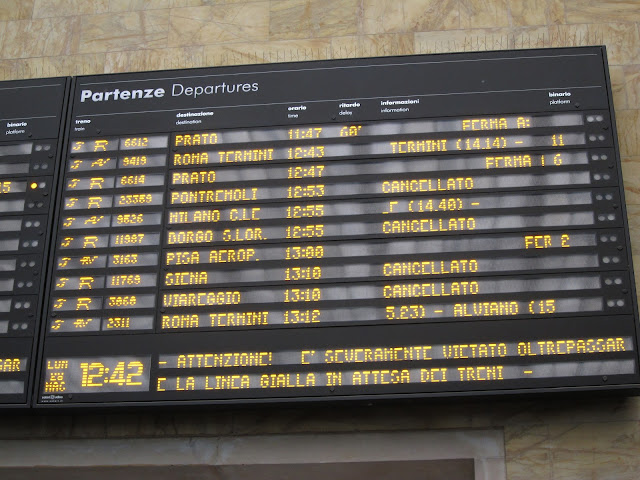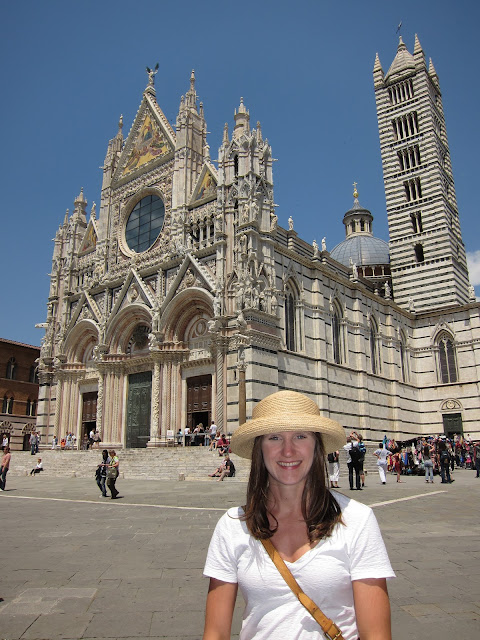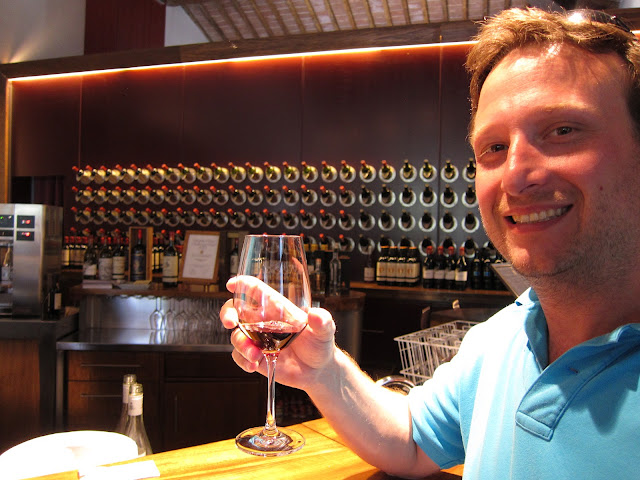Siena, like other Tuscan hill towns, was first settled during the time of the Etruscans (c. 900–400 BC)
when it was inhabited by a tribe called the Saina. The Etruscans were an advanced people
who changed the face of central Italy through their use of irrigation to reclaim
previously unfarmable land, and their custom of building their settlements in well-defended hill-forts.
Whenever we go sightseeing, we seem to arrive at our destination right at lunch-time
so we always eat first, because we've found it is no fun to visit cathedrals
and look at medieval art on an empty stomach. I also haven't been keeping
track of how many days we've eaten pizza but they've all been made
differently at every place we've been to.
I promise we're getting to the important historical stuff, but our lunch spot was a fancy grocery store
and their selection of meats and cheeses was unbelievable...can't get any fresher than this!
The shell-shaped Piazza del Campo, the town square, is another architectural treasure.
It is a massive area filled with people relaxing and taking in the sun while surrounded by beautiful
medieval buildings that have aged incredibly well.
Siena did not prosper under Roman rule but rather as a city-state, becoming
an important money-lender and player in the wool trade.
The Piazza de Campo from the opposite side.
Siena's university, founded in 1240 and famed for its faculties of law and medicine,
is still among the most important Italian universities.
Siena also rivaled Florence in the arts throughout the 13th and 14th centuries.
Medieval relics still chained to the walls in the piazza...perhaps this is why Siena is a
UNESCO World Heritage Sight?
If you have limited time in Italy to see all of it's cathedrals, make sure this one's
on your list. Begun in the 12th century, it is a near perfect example of
Italian Romanesque-Gothic architecture.
It's layout is unusual for a cathedral in that its axis runs north-south.
This is because it was originally intended to be the largest cathedral in the world,
with a north-south transept and an east-west nave, as is usual. After the completion
of the transept and the building of the east wall (which still exists and may be climbed
by the public via an internal staircase) the money ran out
and the rest of the cathedral was abandoned.
The spandrels of the round arches below this cornice exhibit the busts of 36 emperors.
The vaulted roof is decorated in blue with golden stars, replacing frescoes on the ceiling.
Black and white are the colors of the civic coat of arms of Siena and as legend has it,
also linked to black and white horses of the city's founders, Senius and Aschius.
The town's emblem in marble inlaid into the floor.
The emblem is a she-wolf suckling infants Romulus and Remus and can be found all over Siena.
According to legend, Siena was founded by Senius, son of Remus, who was the brother of Romulus,
after whom Rome was named.
Another example of the cathedral's inlaid marble floor...
The floor is one of the most ornate of its kind in Italy, covering the whole floor of the cathedral.
This undertaking went on from the 14th to the 16th centuries,
and about forty artists made their contribution.
Mesmerized by the holiness.
Adjoining the cathedral is the Piccolomini library,
housing precious illuminated choir books and frescoes.
The frescoes tell the story of the life of Siena's favorite son,
cardinal Enea Silvio Piccolomini, who eventually became Pope Pius II.
We always light a candle for someone in all the cathedral's we visit.
Another view of the city.
On the walk back to the car, view of the bell tower from the Piazza del Campo in the distance.
And I continue to stop and smell the roses...and ever single rose is sweeter than before.
On the drive home we happened upon Castello di Brolio and headed up it's driveway.
What a treat we were in for!
We opted for tickets for only the self-guided tour of the gardens as we weren't really interested in a guided tour
of the museum that included half an hour of Italian history.
Eh, no need for half an hour of Italian history to take in a view like this.
All of the surrounding vineyards belong to the castle.
A short history of Brolio Castle:
For centuries the castle was involved in bitter rivalries between Florence allied with
the Papacy, and Siena, a partisan of the Holy Roman Empire, based in Germany.
Built about 1000 A.D. the castle was owned for a while by the monks of Badia Fiorentina
but in 1141 the Ricasoli family traded some other property to the monks in exchange for Brilio
and its surrounding fields, woods and vineyards. The Ricasoli's have been at Brolio ever since,
and are still in ownership of it to this day.
Baron Bettino Ricasoli this is not....
The real guy who the castle belonged to was one of the main creators responsible
for the Unification of Italy. He was also the leader of the Liberal Movement of Tuscany and
was elected Prime Minister twice. Ricasoli also carried out important experiments in the field
of grape growing and vinification which led to the modern concept of Chianti.
The Brolio winery buildings...next time we're taking that tour.
On the drive out we stopped in the wine shop for the complimentary wine tasting of three of the Brolio wines.
On the way home we stopped in the tiny town of Panzano for drinks and dinner
if anything sparked our interest...as for that giant wine bottle in the background,
I think the amount of wine we will have consumed after a month here could fill it.
We didn't do much research on any notable sights to see within any of the Tuscan towns,
instead leaving what we may find to chance....
...and chance led us to this guy, Dario Cecchini,
the famous Dante-quoting butcher from Panzano.
Perhaps the most famous butcher in all of Italy, Cecchini stresses the importance of artisanal butchering
and the use of the whole animal....his shop is full of pre-packaged cuts of beef along with his own spices, mustards,
and his own brand name lemoncello and grapa...and the most exciting part of this discovery
was that we finally found out where the famous Florentine Steak come from -- area #12.
Now this is a meatloaf I would eat.
Not only is the famous butcher innovative with meats, he is also quite the self-promoter, with his own restaurant
located directly across the street, indicated by the Tuscan cow.
The menu was a 10-course tasting menu of meats, meats and more meats...
meat raised by him in Catalunya, Spain and Panzano, Italy....
It was actually a good deal, per person, for the amount of food you get so we signed up for the experience.
Perhaps more exciting than the food was the communal dining experience.
We met a wonderful couple from Germany (who we ended up having dinner with
the next night as well because we all enjoyed each other's company)
and two other couples from Connecticut and New Orleans.
We hope you're enjoying the tour through Italy!
| 

































































